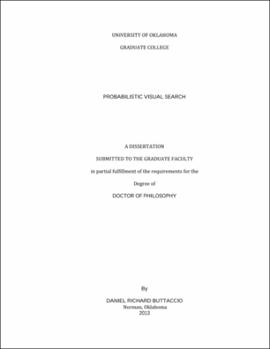| dc.description.abstract | In the present dissertation I examine whether participants are able to use cues that provide probabilistic target information. On each trial, participants are presented with a search array and are asked to find a target and report an attribute of the target (e.g., its orientation). Prior to the onset of the search array, a background cue is presented that provides varying degrees of information regarding the color of the target in the upcoming search array. In Experiment 1, minimal differences in visual search performance (as assessed by reaction times) are found for background cues that are perfectly predictive and moderately predictive of the target color relative to a background cue that is entirely non-predictive. It is argued that participants were not selecting the features of target that were related to the background cues and thus not encoding this information into long-term memory. In Experiment 2, the stimuli in each search array are created such that in order to identify the target\'s orientation the entire target object needs to be selected, including its color. Thus, this ensures that participants are selecting the feature that is related to the background cue. In this experiment, visual search differences are found between background cues that perfectly predict and cues that partially predict the color of the target in the upcoming search from the background cue that is uninformative. However, Experiments 3a and 3b reveal that the participants in Experiment 2 were likely not using the background cues but were relying on target base rate information to improve search. In Experiment 4, the selection of the background cues is encouraged by periodically testing participants regarding the relationship between the background cues and associated target features. A difference is observed between Experiment 4 and 2 such that participants in Experiment 4 were faster, particularly for those participants who learned the relationship between the background cues and its associated colors, suggesting that the participants in Experiment 4 were using the background cues to improve search. Finally, in Experiment 5 participants were eye tracked as they went through the same task as in Experiment 4. Eye track analyses revealed that there was strong guidance towards features that were associated with the background prompts. The results from the present dissertation suggest that the methodology employed is useful for understanding interactions between long-term memory, working memory, and attention. | |
